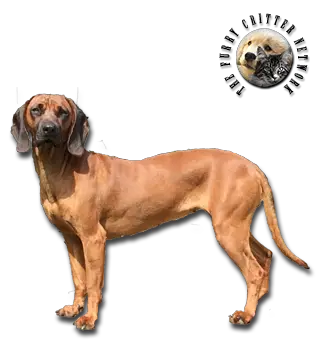Breed Standard
Head: Strong and elongated. Relatively broad, slightly domed skull. Pronouced stop. Slightly curved nosebridge. Sufficiently broad muzzle. Solid jaws. Lips fully covering mouth. Black or dark red nose. Wide nostrils.
Ears: Set on high, medium in length, wide at the base, rounded at the tips, heavy, hanging flat against the head.
Eyes: Neither too large nor too round. Dark brown or somewhat lighter. Pigmented eyelids.
Body: Slightly longer than it is tall. Slightly raised at the rump. Neck medium in length, strong, with a slight dewlap. Topline sloping slightly upward from withers to hindquarters. Chest well-developped, long, moderately wide and well let-down. Slight tuck-up. Long, fairly straight croup. Solid back.
Tail: Set on high, medium in length, hanging to the hock. Carried level to the ground or hanging down.
Hair: Short, dense, lying very flat against the body, moderately harsh. Finer on the head and ears, harsher and longer on the abdomen, legs and tail.
Coat: Fawn, red, reddish-fawn, dark fawn (reddish-brown), light fawn (pale yellow), to sable fawn; fawn grey like a deer's winter coat, also brindled or ticked with black. The background color on the back is usually more intense. Dark muzzle and ears. Tail generally ticked with black. Small, light-colored markings on the chest (flashings) are allowed.
Size: Dog: 47 to 52 cm (18.5 - 20.5 in). Bitch: 44 to 48 cm (17-19 in).
Weight: 20 to 25 kg (44-55lb).
History
All bloodhounds are descended from primitive hunting dogs (brachet scenthounds). Hunters chose the most loyal dogs of the pack and used them to track game wounded in the hunt. From these dogs, breeders developed bloodhounds (Schweisshunde) used uniquely for trailing wounded game. Crosses were also made with local mountain hound breeds (the Ticolar Bracken, the Brandbracken and Dachsbracken). In 1912, the Bavarian Bloodhound Club was founded. The breed is rare.
The Bavarian Mountain Dog was developed in the 19th century by crossbreeding specimens of different hunting dogs from the Alps. The result was a hunting dog ideal for the work in the mountains. In 1912, the Club for Bavarian Mountain hound, was founded in Munich. Afterwards, this breed started gaining popularity in Austria and Hungary. The Bavarian Mountain Dog specialises in tracking injured big game following the traces of blood the prey loses after being shot.
Behavior
Courageous, spirited, fast and agile, the Bavarian Moutain Dog is at ease on a rugged terrain. With his superb nose and powerful hunting instinct, he was originally used on chamois but can hunt al other game. Calm, even tempered, docile, attached to this owner, he is a good companion. As with any bloodhound, he needs a patient, experienced trainer.
The Bavarian Mountain Hound is not suited for city life. He needs space and exercise. He also requires regular brushing.
Function
Hunting Dog.
Health
Similar to other breeds, this dog would need to have regular ear check up to avoid ear infection.






